
Caldas da Rainha is a medium-sized Portuguese city in the Oeste region, in the historical province of Estremadura, and in the district of Leiria. The city serves as the seat of the larger municipality of the same name and of the Comunidade Intermunicipal do Oeste. At the 2011 census, the municipality had a population of 51,729 in an area of 255.69 square kilometres (98.72 sq mi), with 30,343 residing in the city. Although the city itself lies about 10.5 kilometres (6.5 mi) inland, three of the municipality's civil parishes lie on the Atlantic Ocean. Caldas da Rainha is best known for its sulphurous hot springs and ceramic pottery.
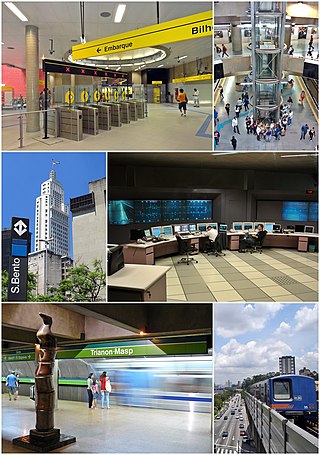
The São Paulo Metro, commonly called the Metrô is a rapid transit system that forms part of the urban railways that serves the city of São Paulo, alongside the São Paulo Metropolitan Trains Company (CPTM), both forming the largest metropolitan rail transport network of Latin America. The six lines in the metro system operate on 104.4 kilometres (64.9 mi) of route, serving 89 stations. The metro system carries about 4,000,000 passengers a day.

REFER, Rede Ferroviária Nacional, EP was the Portuguese rail infrastructure manager. It was a state-owned company and was created to manage the Portuguese rail infrastructure, previously under control of CP, which became exclusively a train service operator.

Soure is a town and municipality of the Coimbra District, in Portugal. The population in 2011 was 19,245, in an area of 265.06 km². It includes a castle listed as a national monument.

CP — Comboios de Portugal, EPE is a state-owned company which operates passenger trains in Portugal. Prior to June 2009, CP stood for Caminhos de Ferro Portugueses although the company has been using its current designation as a brand name since 2004.
The CP Urban Services network is the commuter train network of Metropolitan Lisbon and Metropolitan Porto, Portugal. It is a Comboios de Portugal company. It connects the city centers with the suburbs.

Linha do Vouga(the Vouga line) is the last surviving metre gauge railway line in Portugal still operated by Comboios de Portugal. The other remaining metre gauge lines all closed in 2009. The line is, however, also under the threat of closure.
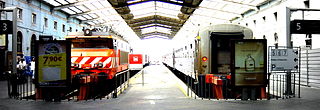
Linha do Norte is the Portuguese main railway line that connects the two main Portuguese cities, Lisbon and Porto. Its length is 336.079 kilometres (208.830 mi). It goes through some other important cities like Vila Franca de Xira, Santarém, Entroncamento, Pombal, Coimbra, Aveiro, Espinho & Vila Nova de Gaia, amongst others. It constitutes the backbone of the Portuguese railway system of freight and passenger services, running approximately 720 trains daily.
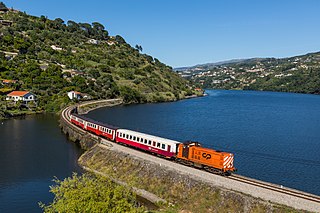
Linha do Douro is a railway in northern Portugal. For much of its route the line runs close to the Douro River, offering very scenic views of the river and valley. Passenger trains on the line are operated by Comboios de Portugal (CP), while the MSC rail subsidiary Medway runs freight trains.
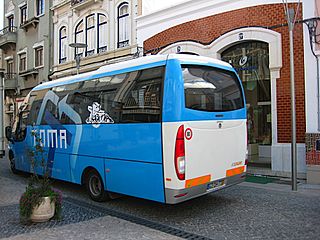
TOMA is the local bus service in Caldas da Rainha, a medium-sized city in western central Portugal. Toma means "take this" in Portuguese, commemorating everyman figure Zé Povinho, whose image appears on the buses. Service was inaugurated by the Câmara Municipal on 15 May 2007, the municipal holiday.

Ramal de Alfarelos is a railway branch in Portugal, which connects the Western Line to the Northern Line, offering a connection between Figueira da Foz and Coimbra.
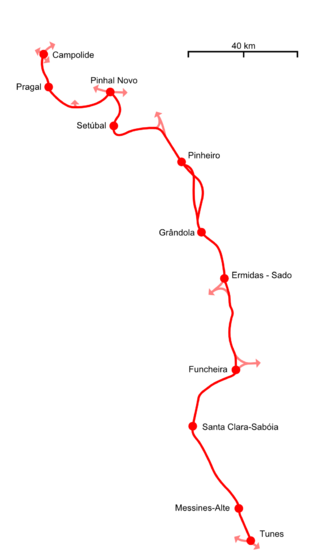
Linha do Sul is a Portuguese railway line which connects Campolide A, in Lisbon, and Tunes, in the Algarve. The first section, from Pinhal Novo to Setúbal, was opened in 1861. The route to Funcheira opened on 25 May 1920. In 2003 it was linked to Lisbon, crossing the Tagus River on the 25 de Abril Bridge.

Linha da Beira Alta is an international railway line which connects Pampilhosa on the Linha do Norte, close to Coimbra, to the border with Spain, at Vilar Formoso.

Linha da Beira Baixa, originally called Caminho de Ferro da Beira Baixa, is a railway line which connects the stations of Entroncamento and Guarda in central Portugal. The first section, from Abrantes to Covilhã was opened on 6 September 1891. The line to Guarda was opened on 11 May 1893. At the time, only the section from Abrantes to Guarda was considered to be part of Linha da Beira Baixa, while the route from Entroncamento to Abrantes belonged to the Linha do Leste. Passenger service on the Guarda-Covilhã segment reopened on 2 May 2021 after it fell into disuse in 2009.
Infraestruturas de Portugal, S.A. (IP) is a state-owned company which resulted from the merger of Rede Ferroviária Nacional (REFER) and Estradas de Portugal (EP). It manages the Portuguese rail and road infrastructure.
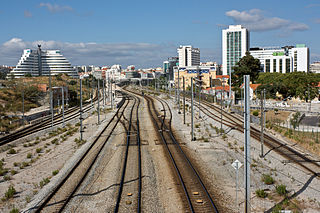
The Cintura Line is a railway line in Lisbon, Portugal. The half circle route was opened in 1888 and serves as a connection between all railway lines in Lisbon: The Cascais, Sul, Sintra, and Norte Lines. There are two railway triangles, one in Sete Rios, and another in Xabregas. It crosses all four Lisbon Metro lines, and connects to three of those at four stations.

Linha de Leixões, also known as Linha de Cintura do Porto, is a freight railway line which connects Contumil railway station, on the Linha do Minho, and Leixões, in Matosinhos, Portugal. It was opened in 1938, and electrified in 1998. Passenger services ran until 1987 and from 2009 to 2011.
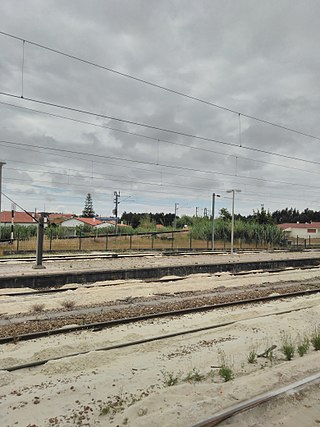
Ramal do Louriçal is a Portuguese railway line managed by Infraestruturas de Portugal which connects Louriçal railway station, on the Linha do Oeste, to two paper factories: Celbi and The Navigator Company. The electrified freight line was opened in 1993.

Ramal da Lousã is a railway line which connects the stations of Coimbra-B, on the Linha do Norte, and Coimbra, in Portugal. It was opened by the Companhia Real dos Caminhos de Ferro Portugueses, under the name Ramal de Coimbra, on 18 October 1885, and was extended to Lousã on 16 December 1906, and to Serpins on 10 August 1930.
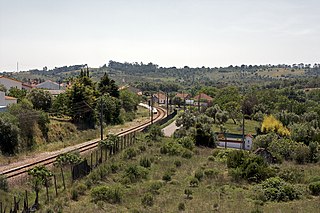
Ramal de Tomar is a Portuguese railway line which connects the stations of Lamarosa, on the Linha do Norte, and Tomar. It was opened on 24 September 1928.



















